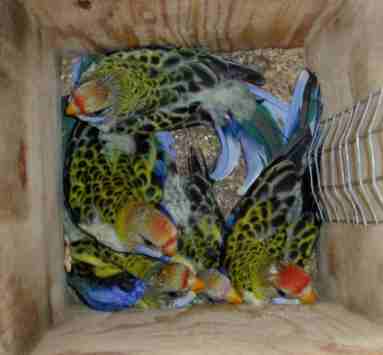Background
information
Australian animals, tree hollows and nestboxes
Australian topics
Nankeen kestrel
Eastern pygmy possum
Green tree frog
Microbats general
Batboxes in
Organ Pipes National Park
Gould's wattled bat
Chocolate wattled bat
Large-footed myotis
Bats, Mosquitoes and Dollars
| Can rosellas smell? |
|
|
| Home / Contact us / Product range / Stories / Pest management / Prices |
Our local rosella is the pale-headed and, where we live, it is in serious decline. Over the last 15 years it has slumped from being a weekly visitor to most properties to visiting just a couple of times a year. This article looks at several reasons why that might be so. Rosellas are fussy. The Europeans have observed, at least since 1956, that hole-nesting birds tend to prefer new nestboxes over ones that are a few years old, even though the latter are often still in very good condition. The reasons for this were investigated in Latvia using data collected over the 20-year period to 2000 (Vilka, 2003). The number of nestboxes surveyed ranged from 530 to 1400 per year. The author considered the following possible causes:
|
|
|
Only the last item—internal brightness, correlated with usage and this correlation was more pronounced with one species than a second. As can be seen from this local photo of rosella chicks in a new box, the ply is very light in colour with lots of light bouncing around. It darkens naturally with age. To translate the behaviour of Latvian flycatchers and tits to Australian rosellas is speculative, to say the least. But in the absence of any local research, it remains a possibility.
|
|
|
Possums in residence. A more
obvious explanation is that the
decrease is in response to an increase in possums, especially
brushtails. Brushtails are obligate hollow-users and they find the space
needed by the typical rosella family of four chicks to be very
comfortable. One ensconced, they are also virtually impossible to budge. This explanation
could also satisfy an oft-mentioned characteristic – that rosellas move
into a newly installed nestbox, often within days, breed immediately
but never again. They may return in subsequent years but their
activities never result in breeding. While undoubtedly true in
some areas, sometimes this happens even though it is known that there
are no possums in the box.
Rosellas can smell. Conventional thinking is that birds generally have a very poor sense of smell. But perhaps not. A British researcher (Roper, 2003) has only recently completed the world’s first study into the sense of smell of any parrot species (using a lorikeet from Indonesia) and he found that they had no trouble distinguishing one smell from another. While this does not prove that rosellas can smell, it does offer yet another possibility for why rosellas breed initially but not again, even though possum numbers may not be high. Possums use their own scent to protect their territory. Years ago we recovered a nestbox that had been used occasionally by brushtails, dumping it in the workshop with other gear from the day’s activities. Before night had completely fallen that box had attracted a possum into the workshop (this had never happened before) to investigate the new smell. This could also explain a curious behaviour of rosellas at a box, involving them resting the front of their head against the box when preparing for breeding. Perhaps they are trying to detect an odour from a possible future predator.
|
|

